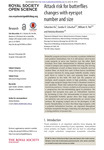Please use this identifier to cite or link to this item:
http://lib.hpu.edu.vn/handle/123456789/21862Full metadata record
| DC Field | Value | Language |
|---|---|---|
| dc.contributor.author | Ho, Sebastian | en_US |
| dc.date.accessioned | 2016-07-04T03:48:58Z | |
| dc.date.available | 2016-07-04T03:48:58Z | |
| dc.date.issued | 2016 | en_US |
| dc.identifier.other | HPU4160349 | en_US |
| dc.identifier.uri | https://lib.hpu.edu.vn/handle/123456789/21862 | en_US |
| dc.description.abstract | Butterfly eyespots are known to function in predator deflection and predator intimidation, but it is still unclear what factors cause eyespots to serve one function over the other. Both functions have been demonstrated in different species that varied in eyespot size, eyespot number and wing size, leaving the contribution of each of these factors to butterfly survival unclear. | en_US |
| dc.format.extent | 13 p. | en_US |
| dc.format.mimetype | application/pdf | en_US |
| dc.language.iso | en | en_US |
| dc.subject | Biology | en_US |
| dc.subject | Behaviour | en_US |
| dc.subject | Ecology | en_US |
| dc.subject | Evolution | en_US |
| dc.subject | Paper models | en_US |
| dc.subject | Predation | en_US |
| dc.subject | Nymphalid | en_US |
| dc.subject | Mycalesis | en_US |
| dc.subject | Intimidation | en_US |
| dc.title | Attack risk for butterflies changes with eyespot number and size | en_US |
| dc.type | Article | en_US |
| dc.size | 1.02MB | en_US |
| dc.department | Education | en_US |
| Appears in Collections: | Education | |
Files in This Item:
| File | Description | Size | Format | |
|---|---|---|---|---|
| 0232_Attackrisk.pdf Restricted Access | 1.05 MB | Adobe PDF |  View/Open Request a copy |
Items in DSpace are protected by copyright, with all rights reserved, unless otherwise indicated.
